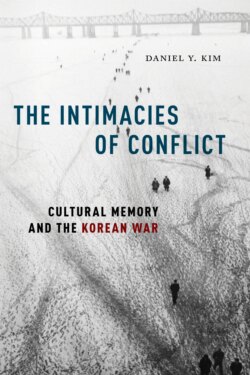The Intimacies of Conflict

Реклама. ООО «ЛитРес», ИНН: 7719571260.
Оглавление
Daniel Y. Kim. The Intimacies of Conflict
The Intimacies of Conflict. Cultural Memory and the Korean War
Contents
Introduction. The Korean War in Color
The Militarized Dimensions of Cold War Orientalism
Reframing the 1950s
Reframing 1950–53
The Intimacies of Cultural Memory
1 “He’s a South Korean When He’s Running with You, and He’s a North Korean When He’s Running after You” Military Orientalism and Military Humanitarianism
The Remaking of a Genre: The Korean War Combat Film
Racial Performances of Legality
A Racial DMZ
2 “Tan Yanks” and Black Korea. Military Multiculturalism and Race War in Movies and the Press
From a “Gigantic War of Color” to the Emergence of Military Multiculturalism
The Korean War in Black and White: Pork Chop Hill and All the Young Men
Madame Butterfly in Black and Yellow: Military Romance and the Korean War
3. Military Orientalism and the Intimacies of Collaboration. Sacrifice and the Construction of the Nisei Citizen-Soldier as a Model Minority
The Romance of Military Orientalism and the Racial Economy of Sacrifice in Go for Broke!
The Politics of “Constructive Collaboration”: The Japanese American Citizens League and the Pacific Citizen
The Rewards of Paying the Price of Freedom: The Crimson Kimono
Coda: Forgetting and Forgotten
4. Picturing Koreans. The Age of the World Target and Humanitarian Orientalism
“The Case of the Mysterious Koreans”: The Meaning of Life and the Korean War
“In Order to Save, at Times We Must Destroy”
“We Sometimes Cut Good Tissue along with Bad Because We Can’t Take the Chances”
5. Angels of Mercy and the Angel of History. The Disfiguring of Humanitarian Orientalism
Lark and Termite: “A Timed Bloodletting with Different Excuses . . . a Long Music”
The Surrendered: Angels of Mercy and the Angel of History
6 “Bled in, Letter by Letter” Postmemory and the Subject of Korean War History
“Authenticity Ultimately Lay in the Story You Could Tell”: The Surrendered
The Foreign Student and the Subject of Korean War History
“They Don’t Know What to Make Me”: The Fictive Parallels of Race
The “Fact of the Secret” and the “Depth of the Rift”
Racialized Assemblages as Translation
7. The Racial Borderlands of the Korean War
Race War, Afro-Orientalism, and Clarence Adams’s An American Dream
“They Rose like Men”: Bringing the 1950s Back Home
“The More One Looks, the More That Is Revealed”
Being a Good Soldier: Rolando Hinojosa’s Rites and Witnesses
Being a Good Reader: Hinojosa’s Asias
War Trash: Neutrality with an Edge
The Ultimate Object of the Novel’s Critique: Us
8. The Intimacies of Complicity
The Guest at Home: “The Atrocities We Suffered Were Committed by None Other Than Ourselves”
The Guest in the Diaspora
Conclusion “The Delicate Chains of War”
The War Memorial of Korea and Virtual Nationalism
Military Orientalism Redux
Rescreening the Korean War
Taegukgi and the Intimacies of Division
Acknowledgments
Notes. INTRODUCTION
CHAPTER 1. “HE’S A SOUTH KOREAN WHEN HE’S RUNNING WITH YOU, AND HE’S A NORTH KOREAN WHEN HE’S RUNNING AFTER YOU”
CHAPTER 2. “TAN YANKS” AND BLACK KOREA
CHAPTER 3. MILITARY ORIENTALISM AND THE INTIMACIES OF COLLABORATION
CHAPTER 4. PICTURING KOREANS
CHAPTER 5. ANGELS OF MERCY AND THE ANGEL OF HISTORY
CHAPTER 6. “BLED IN, LETTER BY LETTER”
CHAPTER 7. THE RACIAL BORDERLANDS OF THE KOREAN WAR
CHAPTER 8. THE INTIMACIES OF COMPLICITY
CONCLUSION
Index
About the Author